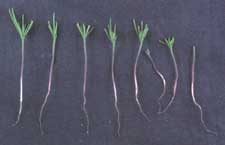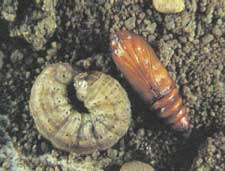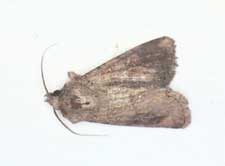CutwormsMarguerita A. Palmer - Principal Plant Pathologist, Pacific Northwest Forest and Range Experiment Station, USDA Forest Service, Corvallis, OR, and Cordell C.E., Anderson R.L., Hoffard W.H., Landis T.D., Smith R.S. Jr., Toko H.V., 1989. Forest Nursery Pests. USDA Forest Service, Agriculture Handbook No. 680, 184 pp. Hosts Cutworms (family Noctuidae) attack a wide variety of both conifer and hardwood seedlings, but damage is generally more severe among conifers. Several species, such as the dingy cutworm (Feltia ducens), attack seedlings in forest tree nurseries. Distribution These pests are found through. out the United States, but the most damaging populations apparently occur in the Lake States and South. Damage Large cutworm populations can destroy thousands of seedlings in only a few weeks. But since such populations develop only during favorable environmental conditions, cutworms are generally only of periodic importance. Diagnosis
Cutworm larvae are stout, hairless, and dull gray in color, ranging from 2 to 5 cm at maturity (fig. 49-2). Moths are extremely hairy, with markings on their forewings but with rather nondescript hind-wings (fig. 49-3). Biology Depending on the geographic location and species of cutworm, there may be more than one generation per year. Some species over-winter as larvae; others as eggs. All species become active in early spring, during the larval stage. They feed and rapidly evolve through as many as seven instars. Cutworm outbreaks occur when favorable environmental conditions allow populations to build up quickly to damaging economic levels. Control Cultural - Maintain nursery beds and keep surrounding areas neatly cultivated and weeded. Fumigation of seedbeds with a methyl bromide-chloropicrin formulation is highly effective in controlling existing populations of soil-inhabitating insects, including cutworms. Selected References Miller. Richard L. 1979. Bug dope. [Publ.] 8.Columbus, OH: Ohio State University. 4 P. Palmer, Marguerita A.; Nicholls, Thomas H. 1981. How to identify and control cutworm damage on conifer seedlings. For. Bull. 510. St. Paul. MN: U.S. Department of Agriculture. Forest Service, North Central Forest Experiment Station. 6 p. |
Forest Pests: Insects, Diseases & Other Damage Agents |

|
|




